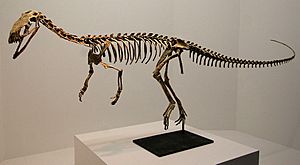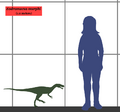Eodromaeus facts for kids
Quick facts for kids Eodromaeus |
|
|---|---|
 |
|
| Restored skeleton | |
| Scientific classification |
Eodromaeus means "dawn runner." It was an extinct dinosaur that lived a very long time ago. This dinosaur belonged to a group called theropods. It lived during the Upper Triassic period in what is now Argentina. Scientists found a nearly complete skeleton of Eodromaeus in 1996. This means many of its bones were still connected!
Some experts, like Paul Sereno, believe Eodromaeus is very important. They think it's one of the earliest true theropod dinosaurs. It helps us understand how dinosaurs first started.
About Eodromaeus
Eodromaeus was a pretty small dinosaur. It was about 1.2 metres (3.9 ft) long from its nose to its tail. That's about the length of a small car! It weighed around 5 kilograms (11 lb), which is like a small dog. Its body was long and thin.
Scientists aren't sure exactly how fast Eodromaeus could run. Some guess it might have run up to 30 kilometres per hour (19 mph). Like all early dinosaurs, Eodromaeus was bipedal. This means it walked on two legs, just like humans do.
Its Body Parts
Eodromaeus's front legs were much shorter than its back legs. Its hands had five fingers. However, the fourth and fifth fingers were very small. This is a common feature in early theropods.
Where it Lived
Eodromaeus lived in the Upper Triassic period. This was about 231 to 229 million years ago. Its fossils were found in the Ischigualasto Formation in Argentina. This area was a lush, green valley back then. It had rivers and forests. Many other early dinosaurs also lived there.
Discovery and Naming
The first nearly complete skeleton of Eodromaeus was found in 1996. It was discovered by a team led by Ricardo Martinez. The official name Eodromaeus murphi was given in 2011. The name Eodromaeus means "dawn runner." The "murphi" part honors Jim Murphy. He helped prepare the fossils for study.
This discovery was very exciting for scientists. It gave them a lot of information. It helped them learn more about the very first dinosaurs.
Images for kids




